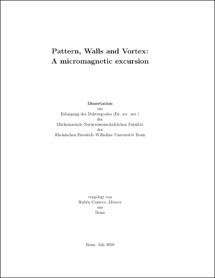Cantero-Álvarez, Rubén: Pattern, Walls and Vortex : A micromagnetic excursion. - Bonn, 2009. - Dissertation, Rheinische Friedrich-Wilhelms-Universität Bonn.
Online-Ausgabe in bonndoc: https://nbn-resolving.org/urn:nbn:de:hbz:5n-19348
Online-Ausgabe in bonndoc: https://nbn-resolving.org/urn:nbn:de:hbz:5n-19348
@phdthesis{handle:20.500.11811/4151,
urn: https://nbn-resolving.org/urn:nbn:de:hbz:5n-19348,
author = {{Rubén Cantero-Álvarez}},
title = {Pattern, Walls and Vortex : A micromagnetic excursion},
school = {Rheinische Friedrich-Wilhelms-Universität Bonn},
year = 2009,
month = nov,
note = {In this thesis, we analyse two different settings in the micromagnetic model, which is a mesoscopic variational model for the description of ferromagnets, more precisely the magnetisation m, which is a local average of spins.
The first of these settings is an elongated thin-film strip. Our interest lies in the formation of a characteristic pattern, the concertina pattern, which is an almost periodic array of magnetic domains separated by Néel walls. We first perform a linear stability analysis for a uniform magnetisation along the long axis of the sample. As shown in (Cantero-Álvarez and Otto, 2006), we have four different scaling regimes for the onset of an instability due to an applied external field. We identify the unstable modes in the two intermediate regimes via a Γ-convergence argument. The third, or second intermediate, regime is shown to feature an instability of nonzero oscillation period in the direction of the long axis of the sample, which supports the conjecture that the concertina pattern may evolve out of this instability.
We then derive a normal form of the bifurcation in the third regime via a weakly nonlinear analysis. Again we resort to Γ-convergence for the derivation of this normal form. The bifurcation is shown to be subcritical. This implies that the phase transition from the uniform magnetisation to whatever state in the third regime is discontinuous. Nevertheless, due to large scale coercivity, which is proved in (Cantero-Álvarez, Otto and Steiner, 2007), and by numerical simulations performed therein and in (Steiner, 2006), it can be shown that there exist concertina-type minimisers near the original uniform magnetisation.
As a result of the weakly nonlinear analysis, we obtain a model for an array of low-angle Néel walls, whose energy scaling we identify for large external fields, by matching upper and lower bounds. For the upper bound, we give a suitable construction, while the lower bound is calculated via suitable estimates.
The second setting we consider is a thin-film disk. For this setting, we investigate the stability of a central vortex. This problem is related to the Ginzburg-Landau problem without magnetic fields. We deviate from the latter by not prescribing Dirichlet data on the magnetisation, but by introducing a boundary penalty instead. The notion of stability for the central vortex is expressed by the positive definiteness of the Hessian of the energy functional evaluated at the central vortex solution, which in turn can be expressed as the positivity of the lowest eigenvalue of the corresponding Rayleigh quotient. We prove stability of the central vortex configuration for both tangential boundary data and a strong boundary penalty under a certain assumption on the lowest eigenvalue of the Rayleigh quotient for variations with zero boundary data.},
url = {https://hdl.handle.net/20.500.11811/4151}
}
urn: https://nbn-resolving.org/urn:nbn:de:hbz:5n-19348,
author = {{Rubén Cantero-Álvarez}},
title = {Pattern, Walls and Vortex : A micromagnetic excursion},
school = {Rheinische Friedrich-Wilhelms-Universität Bonn},
year = 2009,
month = nov,
note = {In this thesis, we analyse two different settings in the micromagnetic model, which is a mesoscopic variational model for the description of ferromagnets, more precisely the magnetisation m, which is a local average of spins.
The first of these settings is an elongated thin-film strip. Our interest lies in the formation of a characteristic pattern, the concertina pattern, which is an almost periodic array of magnetic domains separated by Néel walls. We first perform a linear stability analysis for a uniform magnetisation along the long axis of the sample. As shown in (Cantero-Álvarez and Otto, 2006), we have four different scaling regimes for the onset of an instability due to an applied external field. We identify the unstable modes in the two intermediate regimes via a Γ-convergence argument. The third, or second intermediate, regime is shown to feature an instability of nonzero oscillation period in the direction of the long axis of the sample, which supports the conjecture that the concertina pattern may evolve out of this instability.
We then derive a normal form of the bifurcation in the third regime via a weakly nonlinear analysis. Again we resort to Γ-convergence for the derivation of this normal form. The bifurcation is shown to be subcritical. This implies that the phase transition from the uniform magnetisation to whatever state in the third regime is discontinuous. Nevertheless, due to large scale coercivity, which is proved in (Cantero-Álvarez, Otto and Steiner, 2007), and by numerical simulations performed therein and in (Steiner, 2006), it can be shown that there exist concertina-type minimisers near the original uniform magnetisation.
As a result of the weakly nonlinear analysis, we obtain a model for an array of low-angle Néel walls, whose energy scaling we identify for large external fields, by matching upper and lower bounds. For the upper bound, we give a suitable construction, while the lower bound is calculated via suitable estimates.
The second setting we consider is a thin-film disk. For this setting, we investigate the stability of a central vortex. This problem is related to the Ginzburg-Landau problem without magnetic fields. We deviate from the latter by not prescribing Dirichlet data on the magnetisation, but by introducing a boundary penalty instead. The notion of stability for the central vortex is expressed by the positive definiteness of the Hessian of the energy functional evaluated at the central vortex solution, which in turn can be expressed as the positivity of the lowest eigenvalue of the corresponding Rayleigh quotient. We prove stability of the central vortex configuration for both tangential boundary data and a strong boundary penalty under a certain assumption on the lowest eigenvalue of the Rayleigh quotient for variations with zero boundary data.},
url = {https://hdl.handle.net/20.500.11811/4151}
}






